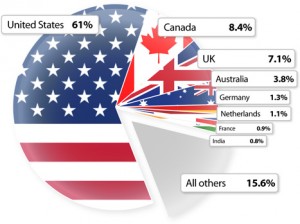Lead Scoring vs. Lead Grading
 Within the B2B marketing niche, the term “lead score” often refers to the quantification of the behaviors and attributes of a marketing lead. But a lead’s score is typically just one component in a lead qualification matrix. A lead’s total rating (hot, warm or cold) is actually a combination of a lead grade and a lead score. In this post we will compare lead scoring vs. lead grading to help you understand the differences.
Within the B2B marketing niche, the term “lead score” often refers to the quantification of the behaviors and attributes of a marketing lead. But a lead’s score is typically just one component in a lead qualification matrix. A lead’s total rating (hot, warm or cold) is actually a combination of a lead grade and a lead score. In this post we will compare lead scoring vs. lead grading to help you understand the differences.
Lead Grade
Marketing leads are graded in most scoring models according to attributes which define the individual and associated business that has responded to a marketing contact. For example, company size – as measured by number of employees – is used to rank the lead’s physical presence within its industry. Grades for attributes are used to determine the lead’s fit within an optimal lead profile. The ranking system used by many automated marketing programs assigns letters such as A, B, C, etc. to leads, usually giving an A for the highest grade attainable.
Lead qualification matrices typically calculate an average of several attribute grades into a composite grade for a sales opportunity. Categories such as location, revenues, title and industry are often included in the calculation. It’s important to keep in mind that a lead can achieve a high grade but a low score due to low level of interest, as measured by its marketing engagement activities.
Lead Score
Marketing leads are scored according to specific activities that indicate interest in a certain solution. Scoring values are typically represented by numbers. Many lead scoring matrices calculate the average score for all activities, which can then be used to determine if the interest level meets the minimum ranking needed to pursue a prospect.
The lead scoring matrix should include both the type of interest and activity level exhibited by your prospect. Examples of scoring criteria include:
Interest Type
- Product Demo Request
- Video View
- White Paper Download
- Email Click-through
Activity Level
- Number of Web Page Views
- Duration of Webinar Attendance
- Number of Emails Opened
Bear in mind that a level of interest in one solution may not translate to interest in other solutions offered by your company. To determine whether a lead would make a good cross-sell or up-sell customer may require a sales engagement or a separate marketing campaign.
Applying Weight and Default Values
Within a lead qualification matrix, some behaviors and attributes are weighted to account for the importance of certain factors. For instance, a prospect’s title may be weighted more heavily than company size. The weight for a certain behavior or attribute is typically represented by multiplying a grade or score by a factor of two through five.
Marketing automation users can assign default values that may differ from company to company. Determining appropriate default values for lead grading and lead scoring is a matter of preference. One company may use a default score of 10 for opening a marketing email, whereas another company may use a default score of 25. The key is to be consistent in assigning default values across all marketing campaigns.











